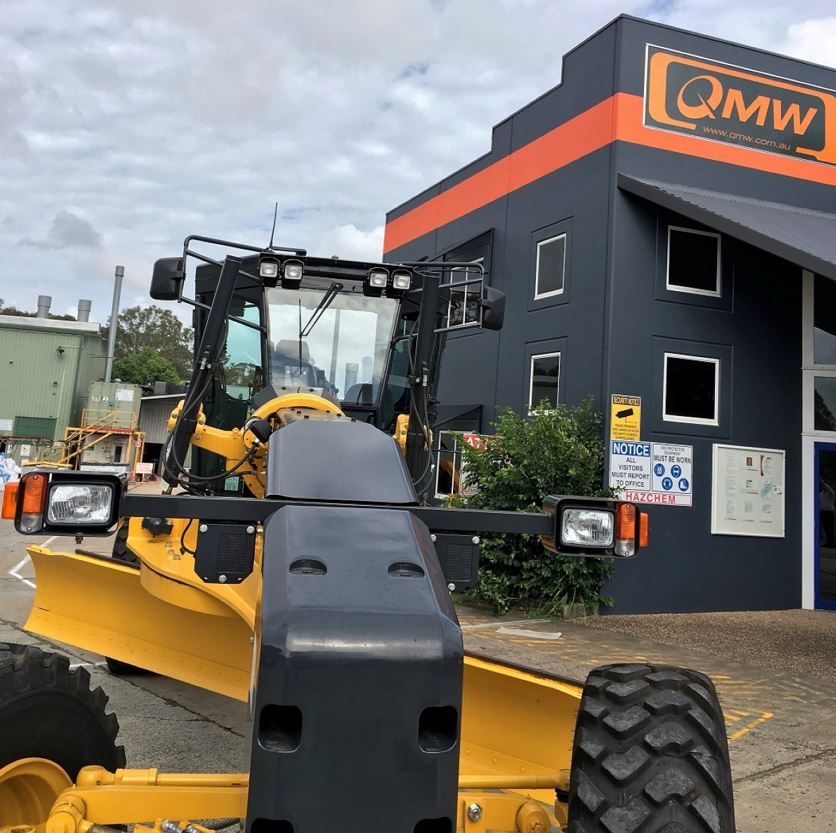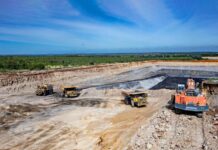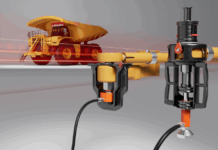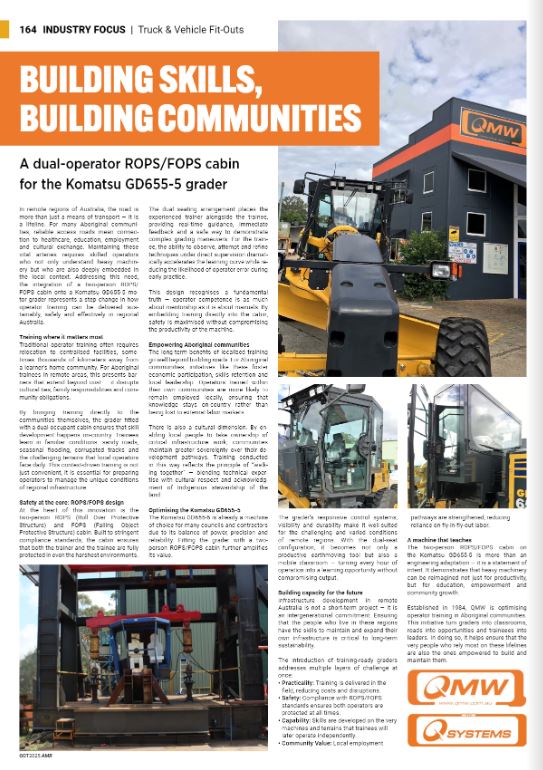Building skills, building communities
A dual-operator ROPS/FOPS cabin for the Komatsu GD655-5 grader

In remote regions of Australia, the road is more than just a means of transport — it is a lifeline. For many Aboriginal communities, reliable access roads mean connection to healthcare, education, employment and cultural exchange. Maintaining these vital arteries requires skilled operators who not only understand heavy machinery but who are also deeply embedded in the local context. Addressing this need, the integration of a two-person ROPS/FOPS cabin onto a Komatsu GD655-5 motor grader represents a step change in how operator training can be delivered sustainably, safely and effectively in regional Australia.
Training where it matters most
Traditional operator training often requires relocation to centralised facilities, sometimes thousands of kilometers away from a learner’s home community. For Aboriginal trainees in remote areas, this presents barriers that extend beyond cost — it disrupts cultural ties, family responsibilities and community obligations.
By bringing training directly to the communities themselves, the grader fitted with a dual-occupant cabin ensures that skill development happens on-country. Trainees learn in familiar conditions: sandy roads, seasonal flooding, corrugated tracks and the challenging terrains that local operators face daily. This context-driven training is not just convenient, it is essential for preparing operators to manage the unique conditions of regional infrastructure.
Safety at the core: ROPS/FOPS design
At the heart of this innovation is the two-person ROPS (Roll Over Protective Structure) and FOPS (Falling Object Protective Structure) cabin. Built to stringent compliance standards, the cabin ensures that both the trainer and the trainee are fully protected in even the harshest environments.
The dual seating arrangement places the experienced trainer alongside the trainee, providing real-time guidance, immediate feedback and a safe way to demonstrate complex grading maneuvers. For the trainee, the ability to observe, attempt and refine techniques under direct supervision dramatically accelerates the learning curve while reducing the likelihood of operator error during early practice.
This design recognises a fundamental truth — operator competence is as much about mentorship as it is about manuals. By embedding training directly into the cabin, safety is maximised without compromising the productivity of the machine.
Empowering Aboriginal communities
The long-term benefits of localised training go well beyond building roads. For Aboriginal communities, initiatives like these foster economic participation, skills retention and local leadership. Operators trained within their own communities are more likely to remain employed locally, ensuring that knowledge stays on-country rather than being lost to external labor markets.
There is also a cultural dimension. By enabling local people to take ownership of critical infrastructure work, communities maintain greater sovereignty over their development pathways. Training conducted in this way reflects the principle of “walking together” — blending technical expertise with cultural respect and acknowledgment of Indigenous stewardship of the land.
Optimising the Komatsu GD655-5
The Komatsu GD655-5 is already a machine of choice for many councils and contractors due to its balance of power, precision and reliability. Fitting the grader with a two-person ROPS/FOPS cabin further amplifies its value.
The grader’s responsive control systems, visibility and durability make it well-suited for the challenging and varied conditions of remote regions. With the dual-seat configuration, it becomes not only a productive earthmoving tool but also a mobile classroom — turning every hour of operation into a learning opportunity without compromising output.
Building capacity for the future
Infrastructure development in remote Australia is not a short-term project — it is an intergenerational commitment. Ensuring that the people who live in these regions have the skills to maintain and expand their own infrastructure is critical to long-term sustainability.
The introduction of training-ready graders addresses multiple layers of challenge at once:
- Practicality: Training is delivered in the field, reducing costs and disruptions.
- Safety: Compliance with ROPS/FOPS standards ensures both operators are protected at all times.
- Capability: Skills are developed on the very machines and terrains that trainees will later operate independently.
- Community Value: Local employment pathways are strengthened, reducing reliance on fly-in-fly-out labor.
A machine that teaches
The two-person ROPS/FOPS cabin on the Komatsu GD655-5 is more than an engineering adaptation — it is a statement of intent. It demonstrates that heavy machinery can be reimagined not just for productivity, but for education, empowerment and community growth.
By optimising operator training in Aboriginal communities, this initiative turns graders into classrooms, roads into opportunities and trainees into leaders. In doing so, it helps ensure that the very people who rely most on these lifelines are also the ones empowered to build and maintain them.

























